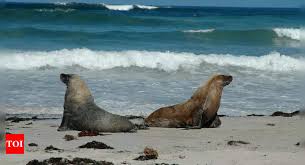By: Matthew Wang
Australian PhD student Nathan Angelakis, studying at the University of Adelaide and a group of fellow researchers used a never before seen technique to help map out the ocean floor and locate endangered ecosystems to help protect them. In a study published on August 7, 2024, the team used eight sea lions, four of whom were named Daphne, Phoebe, Iris and Pasithea, allowing the team to successfully obtain valuable data without the need for expensive technology.
This ecological data was obtained by attaching small sensors and a camera to the sea lions, allowing the researchers to know what direction and what speed the animals were traveling. After attaching the devices with an adhesive which could be quickly shed by the sea lions and watching them leave, the researchers waited for their helpers to return to shore to their pups, resulting in a treasure trove of data.
The videos and other data obtained from the sea lions was extraordinary, giving a close up view to ecosystems that were largely unmapped and unknown. Plugging the video along with other data captured such as GPS into a machine learning algorithm which was trained to identify ocean habitats, these researchers got an incredible insight of the sea lion’s common habitats, information crucial to keep the endangered animals from going extinct.
Outside of helping scientists map out the ocean floor, this footage recovered revealed yet another spectacular scene, one of the sea lions teaching her pup to hunt. In an interview with The New York Times, Mr. Angelakis stated that “[Daphne] was taking her pup out to sea, and that’s the first direct evidence that we’ve collected of Australian sea lion mothers teaching or passing on their foraging skills to their pups.”
This innovative strategy allowed the scientists to easily map the ocean floor, without the need for expensive equipment such as seafaring robots. A typical venture this deep down would have required the usage of highly specialized robots, which were both expensive and clunky to use. Using the sea lions, who already lived in these ecosystems, allowed the scientists to obtain important data more efficiently.
With the new data recovered, animal conservation efforts now have more data to further prevent the extinction of these animals. Due to the elusive nature of the ocean, often requiring hard-to-get technology to map even tiny parts of it, conservationists had to guess what areas to protect. With the new videos, these experts may finally have a better idea in how to protect these quickly dying animals in the future.











